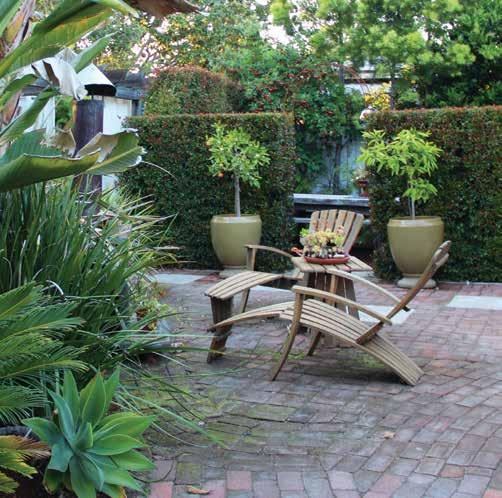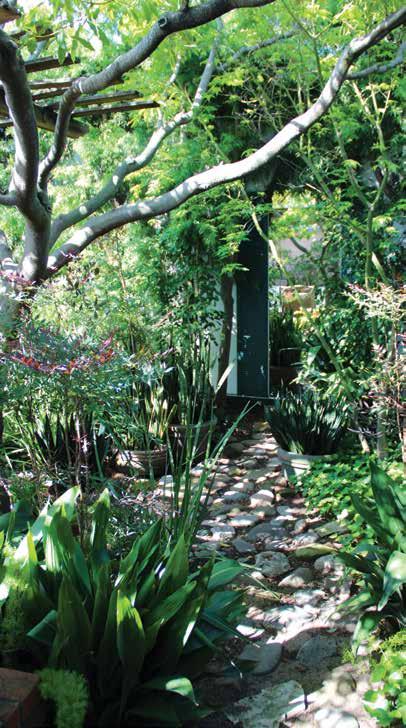
4 minute read
DWELLING



Organic Evolution
Back in 1995, when Steve Carlson was searching for a home to buy, he knew one thing: he wanted a California Spanish-style bungalow from the 1930’s. After a lot of patience and many dead-end leads, one finally came on the market.
Located on Meinecke Street in San Luis Obispo, Carlson and his wife now observe that it is the neighbors, and not the impossibly hip coved ceilings of the bungalow— something he now calls a “silly prerequisite” of his house quest—that makes their home the refuge it has become.
It would have been impossible to forecast almost twenty years ago that Carlson, a native to San Luis Obispo and a Cal Poly graduate, was actually buying into a close-knit community as much as he was acquiring real estate. But today, four relatively small homes—after an addition, the
Carlson home is 1,500 square-feet—sitting on relatively small lots have created what amounts to a city park in their collective backyards.
As we wander around and through the properties one afternoon, Carlson launches into a long history of the various people who have come and gone over the years.
One was once a tenant of the place next door who then bought the house on the other side. Another was a younger family who are now empty-nesters. And so on.
It was a “real communal spirit” as Carlson describes it that led the neighbors to declare “let’s just try to keep it as open as possible.” The idea was to enjoy the interaction with each other while also respecting one another’s privacy. The result has been an interesting experimentation in modern backyard living.
One of the great things about living in a small house according to Carlson is that, “it encourages you to get out and make the outside livable and palatable.” Carlson and his wife, Louise, who grew up in New Zealand, did not have a grand plan for their property. Instead, Carlson describes it as an “organic evolution” where the goal was to reuse and salvage as much as they could from the existing yard.
On many weekends during the early years, neighbors from all four houses could be found working together outside, discussing ideas, sharing tools, and lending a helping hand.
The days were often capped by an evening barbeque with each neighbor bringing a dish to share. Although most of the heavy lifting has long since passed, the outside remains central to the livable-ness of the homes, and on occasion the neighbors still dine together out back.
>>



BEFORE With nary a focal point in site, the landscape was flat, dry, and uninspired. [ ]

A practical reason for the liberal planting in their backyards is that the homes are situated on a street that hosts a significant amount of traffic. The road noise has been dampened significantly by design. One of the neighbors makes the centerpiece of his backyard a perpetually running fountain. The water feature drowns out the noise and is easily heard from the neighboring yards.
But, it is the clever use of “small spaces within a small space” that creates interest and intrigue for the visitor. The backyard gardens are all curved and designed to create distinct areas. The Carlsons, for example, have framed out a dining area with carefully manicured boxwood shrubs. >>


[AMBIANCE White curtains and three side-by-side full length mirrors, all beneath a pergola, make this intimate outdoor space boil over with hip factor. ]


Although there is so much sensory stimulation, the focal point, if there is one, is the outdoor stove nestled into the exterior of the Carlson home, just off the main patio. Here the family eats many of their meals and huddles around the fire during cold nights.
Scanning the yard, it is difficult to tell where one lot ends and another begins. And that is exactly the idea. “When I explain to people what we have done, they are often caught off-guard by it. For other people, it immediately strikes a nerve and they say, ‘Wow, that’s great. I love it!’ But then they usually ask, ‘Can you do that?’”
Poet Robert Frost wrote that “good fences make good neighbors,” but Carlson is genuinely puzzled by the interest people have in the homes’ lack of fences. He observes, “I think sometimes we just take the traditional way of living for granted, but there is always a different way.” SLO LIFE










